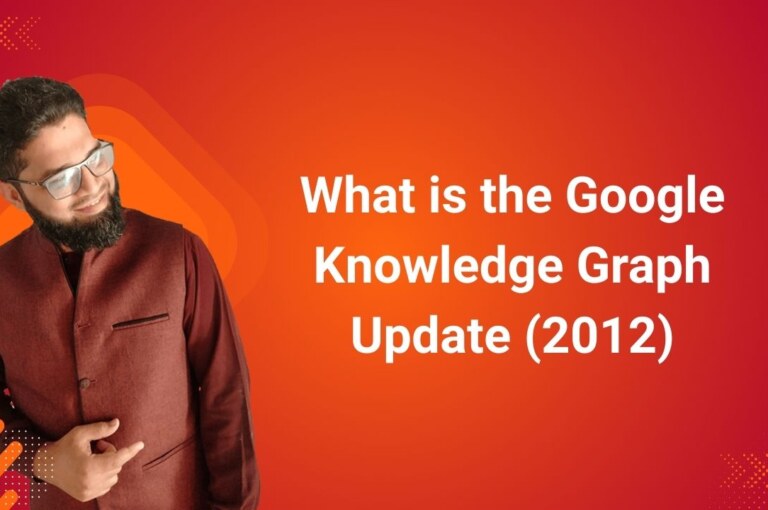What is the Google Knowledge Graph Update (2012)?
Launched in 2012, the Google Knowledge Graph revolutionized how Google understands and presents search results. This algorithm update moved beyond keyword-based search results and incorporated a semantic understanding of relationships between various entities, such as people, places, things, and concepts.
The Knowledge Graph connects search queries to a vast, real-world database and presents information more intuitively, improving user experience and search result accuracy.
Why Was the Knowledge Graph Introduced?
Before the Knowledge Graph, search engines relied on keywords to match search queries to web pages. While this method worked for simple searches, it often struggled with complex queries or those requiring contextual understanding.
The Knowledge Graph was introduced to overcome these limitations by providing:
Context: Connecting various entities and their relationships.
Accuracy: Offering answers that align with a user’s intent, not just keywords.
Real-World Relevance: Using data from trusted sources like Wikipedia, Freebase, and licensed databases to provide more meaningful, relevant search results.
How Does the Knowledge Graph Work?
At its core, the Google Knowledge Graph operates as a vast network of interconnected entities and their relationships. Here’s how it works:
Search Queries: When a user enters a search query, Google’s algorithms analyze it for context and meaning.
Entity Identification: Google identifies key entities within the query (e.g., “Albert Einstein,” “Mount Everest”).
Entity Relationships: The Knowledge Graph then connects these entities to related concepts, using structured data.
Display Knowledge Panels: Google displays this information directly in the search results, such as Knowledge Panels or carousels, allowing users to access accurate details without clicking through to a website.
Key Features of the Google Knowledge Graph
1. Knowledge Panels
Appear on the right side of the SERP and offer a summary of key facts about an entity.
Example: A search for “Leonardo da Vinci” might show his birthdate, notable works, and relationships to other historical figures.
2. Improved Search Understanding
Google can now understand relationships between entities, providing a more comprehensive result.
Example: Searching for “Steve Jobs” might show connections like “Founder of Apple” and “Co-Founder of Pixar.”
3. Direct Answers
The Knowledge Graph allows Google to answer queries directly in the search results (e.g., “How tall is Mount Everest?”).
Impact of the Knowledge Graph on Search Results
The introduction of the Knowledge Graph made search results more intuitive and contextual:
1. Faster Information Access:
Users can quickly find answers to factual questions directly in the search results.
2. Reduced Click-Through Rate:
Since information is often displayed within the SERP itself, users may not need to click on a link, reducing website traffic for informational queries.
3. Rich Snippets:
Google displays more detailed information like ratings, event dates, and specific facts.
Example: Searching for “The Godfather” might show the film’s release year, director, and cast directly in the SERP.
How Has the Knowledge Graph Influenced SEO?
The launch of the Knowledge Graph drastically changed SEO strategies:
1. Entity-Based Optimization:
SEO strategies shifted from keyword optimization to entity optimization, meaning content should be structured around real-world entities and their relationships.
2. Structured Data Markup:
Websites began using schema.org markup to help Google understand their content, allowing for richer search results like Knowledge Panels.
3. Local Search Optimization:
The Knowledge Graph enhanced local search results, integrating data like business reviews, hours, and locations, boosting visibility in local searches.
4. Authority and Trust:
Having a strong online presence and being cited by reputable sources became crucial for showing up in Knowledge Panels.
Challenges of the Knowledge Graph
While the Knowledge Graph enhanced search results, it introduced several challenges:
1. Accuracy Issues:
If incorrect or incomplete information is fed into the Knowledge Graph, it can result in misleading results.
2. Content Loss:
If your website’s information isn’t featured in the Knowledge Graph, you may miss out on visibility in rich snippets and Knowledge Panels.
3. Complex SEO:
Optimizing for entities and structured data requires a deeper understanding of semantic search and technical SEO.
How Has the Knowledge Graph Evolved?
Since 2012, Google has made continuous updates to expand the Knowledge Graph:
Increased Entity Coverage: More entities are included, improving the breadth of knowledge.
Multilingual Support: The Knowledge Graph now works across multiple languages, making it more accessible to global users.
AI Integration: Google’s use of machine learning and natural language processing has enhanced its ability to understand and interpret complex queries.
The Future of the Knowledge Graph
The future of the Google Knowledge Graph is tied to the integration of emerging technologies like:
Voice Search: As voice searches grow, the Knowledge Graph will increasingly provide conversational, direct answers.
Augmented Reality (AR): Information from the Knowledge Graph could be used in AR systems to display real-time data.
Internet of Things (IoT): The Knowledge Graph could power data-sharing across connected devices for a smarter, more personalized experience.
Final Thoughts on Knowledge Graph
The Google Knowledge Graph Algorithm Update transformed search by adding context, relationships, and structure to search results. By focusing on entities rather than just keywords, it shifted the SEO landscape toward semantic search and structured data optimization. As the Knowledge Graph evolves, it will continue to shape the future of search engines, making it essential for businesses to optimize for entity-related data and structured markup.
Embrace the Knowledge Graph’s capabilities to stay ahead in SEO — optimize your content, structure data effectively, and ensure your entity is recognized across the web.
Want to Go Deeper into SEO?
Explore more from my SEO knowledge base:
▪️ SEO & Content Marketing Hub — Learn how content builds authority and visibility
▪️ Search Engine Semantics Hub — A resource on entities, meaning, and search intent
▪️ Join My SEO Academy — Step-by-step guidance for beginners to advanced learners
Whether you’re learning, growing, or scaling, you’ll find everything you need to build real SEO skills.
Feeling stuck with your SEO strategy?
If you’re unclear on next steps, I’m offering a free one-on-one audit session to help and let’s get you moving forward.




